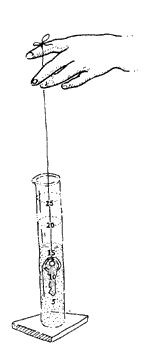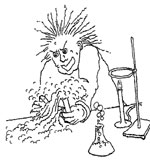|
Most of the books involve the use of chemistry
and chemical reactions as a tool to solving a mystery or problem
in a fictional situation. Occasionally the chemistry gets people
in trouble, but, just as in real life, it’s usually the injudicious
use of chemistry that creates the problem! For the most part,
these books are appropriate for students at the younger end of
the age range for this guide.
Though chemistry is not the focus of any of these books, certain
key concepts such as combining reactants to form new products,
the need to record data, the idea that more is not always better,
and that some things are irreversible appear throughout the stories.
Also, fun kid-use of chemical names and formulas can make this
sometimes intimidating aspect of chemistry friendlier.
Everything Happens to Stuey
Gorky Rises
June 29, 2020
The Lady Who Put Salt in Her Coffee
The Monster Garden
Susannah and the Poison Green Halloween
Everything Happens to Stuey
by Lilian Moore; illustrated by Mary Stevens
Random House, New York. 1960
Out of print
Grades: 4–7
After smelling up the refrigerator with his secret formula,
turning his sister’s doll green with a magic cleaner, and
having his invisible ink homework go awry, budding chemist Stuey
is in trouble. In the end, he uses his knowledge to rescue his
sister by fabricating a homemade flashlight. The illustrations,
depiction of family life, and sex roles are dated, but the spirit
of adventure is timeless.
Return to title list.
Gorky Rises
by William Steig
Farrar, Straus & Giroux, New York. 1980
Grades: 2–5
When Gorky’s parents leave the house, he sets up a laboratory
at the kitchen sink and mixes up a liquid mixture with a few secret
ingredients—his mother’s perfume and his father’s
cognac! The liquid proves to have magical properties which allow
him to fly over the world. Students in Session 1 mix chemicals
to make something new just as Gorky does. Although it is a picture-book
format, the content makes it usable for older students.
Return to title list.
June 29, 2020
by David Wiesner
Clarion Books, Houghton Mifflin, New York. 1992
Grades: 3–6
The science project of Holly Evans takes an extraordinary
turn—or does it? This highly imaginative and humorous book
has a central experimental component, and conveys the sense of
unexpected results—one of the lessons of the reaction in
Session 1..
Return to title list.
The Lady Who Put Salt in Her Coffee
by Lucretia Hale
Harcourt, Brace, Jovanovich, San Diego. 1989
Grades: K–6
When Mrs. Peterkin accidentally puts salt in her coffee, the
entire family embarks on an elaborate quest to find someone to
make it drinkable again. Visits to a chemist, an herbalist, and
a wise woman result in a solution, but not without having tried
some wild experiments first.
Return to title list.
The Monster Garden
by Vivien Alcock
Delacorte Press, New York. 1988
Grades: 5–8
Frankie Stein creates her own special monster from a “bit
of goo” her brother steals from the lab. Scientific information
is sprinkled throughout the book and Chapter II includes Frankie’s
experiment log. The book is a combination of fantasy, science
fiction, and young adult novel with a strong main character, an
arrogant older brother, and a “friend” who spills the
secret. It stimulates thinking about the complex issues surrounding
biotechnology and genetic engineering. Students who read this
book after doing the GEMS Chemical Reactions activities
could be asked to write or diagram a short and imaginative explanation
for the chemical reactions that might have taken place as Frankie’s
monster was formed.
Return to title list.
Susannah and the Poison Green Halloween
by Patricia Elmore; illustrated by Joel Schick
E.P. Dutton, New York. 1982
Grades: 5–7
Susannah and her friends try to figure out who put the poison
in their Halloween candy. Tricky clues, changing main suspects,
and some medical chemistry make this an excellent choice, with
lots of inference and mystery.
Return to title list.
|


|


